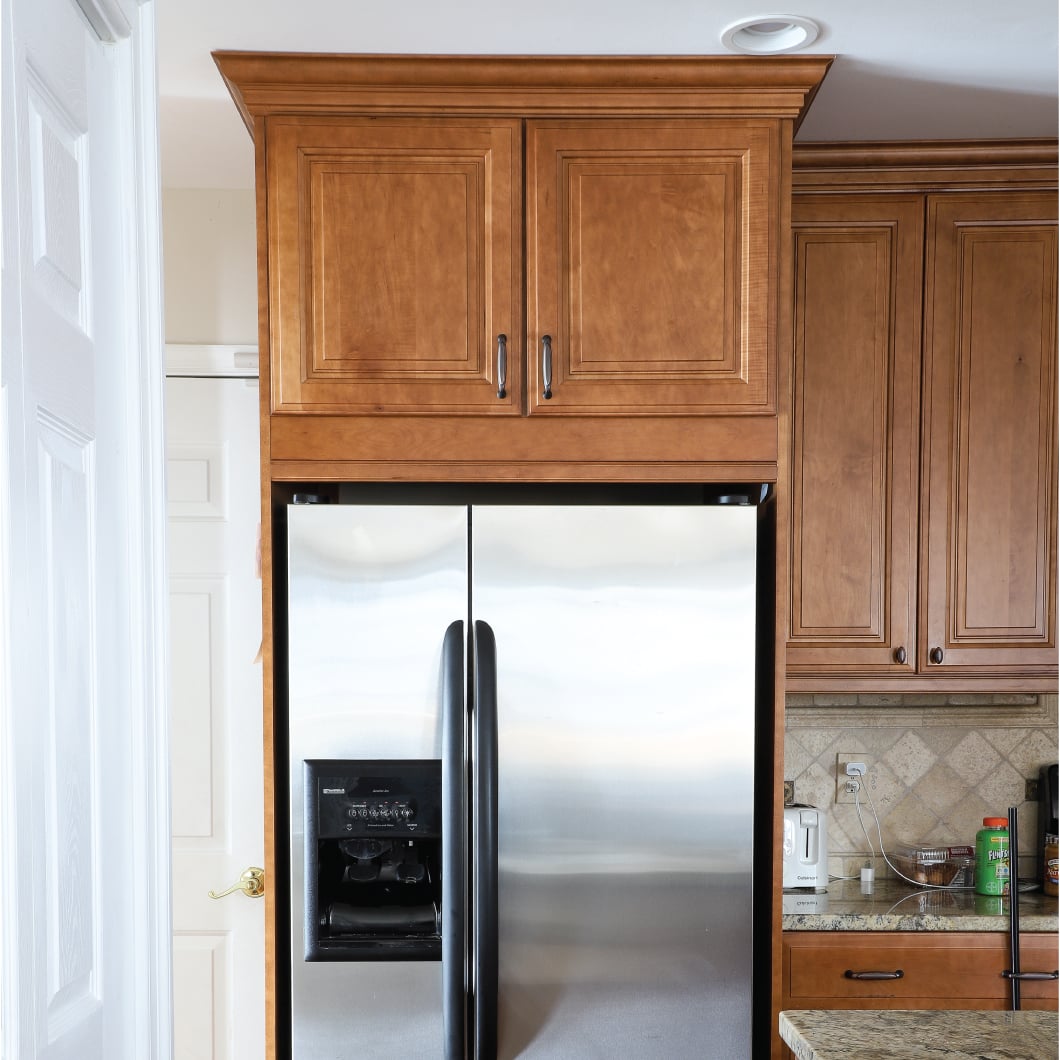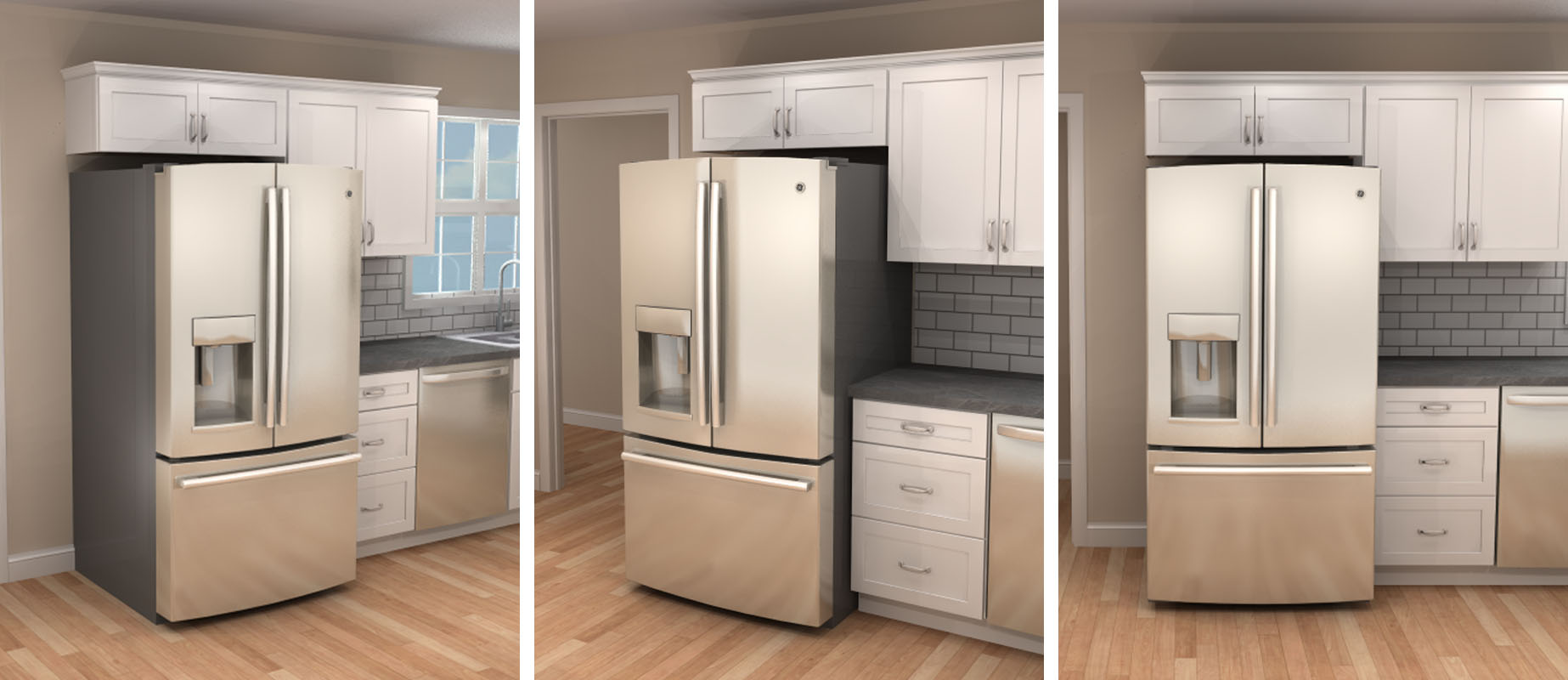Planning and Design Considerations

Integrating kitchen cabinets around your fridge can be a game-changer, but it’s a decision that needs some careful thought. You’ve got to weigh the pros and cons, think about your kitchen layout, and make sure it all works with the size of your fridge.
Cabinet Configurations
Choosing the right cabinet configuration is key to making the most of the space around your fridge. There are a few common options:
- Wraparound: This is where cabinets completely enclose the fridge on all sides. It’s great for maximising storage, but you need to make sure you have enough space and that your fridge is the right size for the layout.
- Flanking: This involves placing cabinets on either side of the fridge, leaving the back and top open. It’s a good option for smaller kitchens or if you want to keep things open and airy.
- Single-Sided: This is where you have cabinets on just one side of the fridge. It’s a good option for creating a dedicated pantry or storage area.
Optimal Placement of Cabinets Around a Fridge
Here’s a table that shows how to best position cabinets around your fridge for different kitchen sizes:
| Kitchen Size | Cabinet Configuration | Placement Notes |
|---|---|---|
| Small | Flanking or Single-Sided | Avoid wraparound configurations to prevent a cramped feel. Opt for shallow cabinets to maximise space. |
| Medium | Wraparound or Flanking | Wraparound configurations work well in medium-sized kitchens. Consider a combination of open shelving and cabinets for a balanced look. |
| Large | Wraparound | Wraparound configurations are ideal for maximising storage in large kitchens. Use deep cabinets for ample storage. |
Cabinet Types and Materials: Kitchen Cabinets Around Fridge

Choosing the right cabinet style and materials for your kitchen is a crucial decision. This section delves into the popular cabinet types and materials, highlighting their advantages and disadvantages to help you make an informed choice.
Cabinet Styles
Different cabinet styles offer a range of aesthetic appeal and suitability for various kitchen layouts. Here’s a breakdown of some popular styles:
- Shaker: Known for their simple, timeless design with recessed panels and clean lines. Shaker cabinets are versatile, blending well with traditional, modern, and transitional kitchens. They are often made from solid wood or MDF, offering durability and a classic look.
- Contemporary: These cabinets feature sleek, minimalist designs with flat panels and modern hardware. Contemporary cabinets are ideal for modern kitchens, offering a clean and uncluttered aesthetic. They are typically made from materials like lacquered wood, high-gloss finishes, or metal, adding a touch of sophistication.
- Farmhouse: Inspired by rural charm, farmhouse cabinets feature rustic elements like beadboard doors, decorative hardware, and distressed finishes. They are perfect for creating a warm and inviting atmosphere, often paired with open shelving and butcher block countertops.
Cabinet Materials
The choice of cabinet material significantly impacts the overall look, durability, and cost of your kitchen. Here’s a detailed analysis of common cabinet materials:
- Wood: Solid wood cabinets offer unmatched durability, natural beauty, and longevity. They are available in various species like oak, maple, cherry, and walnut, each offering unique grain patterns and color variations. However, solid wood cabinets can be expensive and require regular maintenance, including refinishing over time.
- Laminate: Laminate cabinets are cost-effective and durable, offering a wide range of colors and patterns to match any kitchen style. They are easy to clean and resist scratches and stains. However, laminate can be prone to chipping and may not have the same natural beauty as solid wood.
- MDF: Medium-density fiberboard (MDF) is a versatile material offering a smooth surface and consistent finish. It is often used as a base for custom cabinetry and can be painted or stained to achieve different looks. However, MDF is not as durable as solid wood and can be susceptible to moisture damage.
Cabinet Materials Comparison Table, Kitchen cabinets around fridge
| Material | Key Characteristics | Applications Around a Fridge |
|---|---|---|
| Solid Wood | Durable, natural beauty, wide range of species, expensive, requires maintenance | Suitable for all styles, especially traditional and farmhouse kitchens |
| Laminate | Cost-effective, durable, wide range of colors and patterns, easy to clean, can chip | Suitable for modern and contemporary kitchens, budget-friendly option |
| MDF | Versatile, smooth surface, consistent finish, susceptible to moisture damage | Suitable for custom cabinetry, can be painted or stained |
Functional Considerations and Tips

Designing cabinets around your fridge isn’t just about aesthetics, it’s about making your kitchen work for you. Think about how you use your fridge and what you need to access easily. This is where the magic of smart storage and accessibility comes into play.
Accessibility and Ease of Use
Making your fridge accessible is key. No one wants to be contorting themselves to grab a carton of milk or a jar of pickles. Here’s how to make it a breeze:
* Height: Ensure the cabinets are at a comfortable height for you to reach. You don’t want to be stretching or bending over. Consider using adjustable shelves to customize the height to your needs.
* Depth: Don’t go overboard with depth. A deeper cabinet might seem like more space, but it can make accessing items at the back a pain. Opt for shallower cabinets or use pull-out shelves to maximize visibility and reach.
* Clearance: Leave enough space around the fridge for easy opening and closing. You don’t want to be bumping your hips or struggling to pull out the door. Allow at least 18 inches on either side of the fridge and a minimum of 36 inches in front.
Storage Solutions
Think outside the box (or cabinet) when it comes to storage. You can maximize every inch of space with these clever solutions:
* Pull-Out Shelves: These are a game-changer for maximizing space and accessibility. You can easily see and reach everything, even in the back of the cabinet. They come in various sizes and configurations, so you can find the perfect fit for your needs.
* Lazy Susans: These rotating shelves are perfect for corners or awkward spaces. They allow you to access everything easily without having to reach into the back of the cabinet. They’re ideal for storing spices, jars, or other items that you frequently use.
* Vertical Organizers: These are great for maximizing vertical space. They can be used to store items like cutting boards, baking sheets, or even pots and pans. This helps to keep your cabinets organized and clutter-free.
* Drawer Dividers: These can help you keep your drawers organized and tidy. They’re especially useful for storing utensils, knives, or other small items. You can find dividers in a variety of materials, from plastic to wood.
Ventilation and Lighting
You might not think about ventilation when it comes to kitchen cabinets, but it’s important, especially around your fridge. A well-ventilated cabinet will help prevent moisture buildup, which can lead to mold and mildew. Here’s what you need to know:
* Ventilation: Ensure your cabinets have adequate ventilation to prevent moisture buildup. This can be achieved through small gaps in the back or bottom of the cabinets. Consider using a vent fan or installing a vent in the cabinet itself.
* Lighting: Good lighting is essential for any kitchen, but it’s especially important in cabinets around the fridge. You want to be able to see what you’re looking for without having to strain your eyes. Consider using under-cabinet lighting or installing a small light inside the cabinet.
Kitchen cabinets around fridge – Planning your kitchen layout around the fridge is essential, but it can be tricky to ensure a seamless look. If you’re struggling with cabinet doors that don’t line up , it might be a sign of uneven floors or poorly installed cabinets.
A professional can help you achieve a perfect fit for your kitchen cabinets, even around the fridge, creating a visually appealing and functional space.
Designing your kitchen around the fridge is all about functionality and flow. To create a cohesive look, consider matching your cabinets to the fridge’s aesthetic. Olive green kitchen cabinets can provide a timeless elegance and pair beautifully with stainless steel fridges.
This color choice can add a touch of sophistication to your kitchen, seamlessly blending with your fridge and creating a harmonious overall design.
